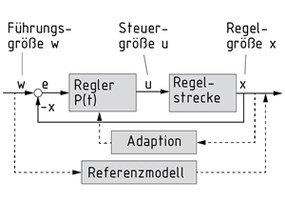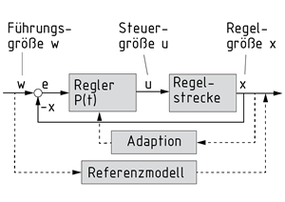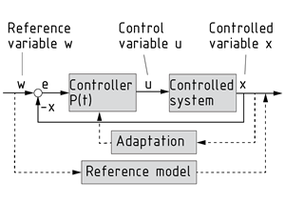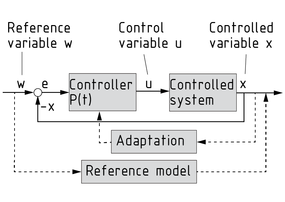
Seleccione uno
o más idiomas
0,1,3
- Alemán
- Inglés
- Chino
- Español
Control adaptable

Un sistema de control adaptable (MRAC = Control adaptable de referencia de modelo) puede adaptar sus parámetros de control al proceso a ser controlado. El control de estado estable convencional llega rápidamente a sus límites si los parámetros del sistema controlado no son conocidos o si cambian. Dichos parámetros desconocidos incluyen las variables atmosféricas como la presión del aire y la velocidad del viento para un sistema de control de vuelo automático, las concentraciones de material de diferentes lotes en la ingeniería de proceso o, por ejemplo, la masa de un objeto movido por un robot.
Un sistema de control adaptable se basa en un sistema de control con parámetros de controlador variable $P(t)$. Estos parámetros variables son adaptados de tal manera que el sistema de control corresponde a la respuesta de entrada y de salida de un sistema controlado en un modelo de referencia. La calidad del control se puede mejorar al ajustar de manera continua los parámetros del controlador, en lugar de dejarlos con los valores nominales de un estado operativo nominal.
Diagrama de bloque de control adaptable
Adaptive Regelung

Eine adaptive Regelung (MRAC: Model Reference Adaptive Control) kann ihre Regelparameter an den zu regelnden Prozess anpassen. Sind die Parameter der Regelstrecke unbekannt oder veränderlich, stößt die klassische statische Regelung schnell an ihre Grenzen. Solche unsicheren Parameter können atmosphärische Größen wie Luftdruck oder Windgeschwindigkeit für eine automatische Flugregelung sein, Stoffkonzentrationen verschiedener Chargen eines verfahrenstechnischen Prozesses oder zum Beispiel auch die Masse eines von einem Roboter bewegten Gegenstandes.
Eine adaptive Regelung baut auf einer Regelung mit den veränderlichen Reglerparametern $P(t)$ auf. Diese veränderlichen Parameter werden so angepasst, dass die Regelung dem Ein- und Ausgangsverhalten eines geregelten Systems in einem Referenzmodell entspricht. Die Regelgüte wird dann erhöht, wenn die Reglerparameter, statt sie auf den Nominalwerten eines Nennbetriebszustandes zu belassen, ständig nachgeführt werden.
Adaptive control

An adaptive control system (MRAC = Model Reference Adaptive Control) can adapt its control parameters to the process to be controlled. Conventional steady-state control quickly reaches its limits if the Controlled system's parameters are not known or they change. Such uncertain parameters include atmospheric variables such as air pressure and wind speed for an automatic flight control system, Material concentrations of different batches in process engineering or, for example, the mass of an object moved by a robot.
An adaptive control system is based on a control system with the variable controller parameters_x000B_$P(t)$. These variable parameters are adapted in such a way that the control system corresponds to the input and output response of a controlled system in a reference model. Control quality can be improved by continuously adjusting the controller parameters rather than leaving them at the nominal values of a nominal operating state.
自适应控制

自适应控制系统(MRAC = 模型参考自适应控制)可以根据被控制的过程调整其控制参数。如果受控系统的参数未知,或参数发生了改变,那么传统的稳态控制会迅速达到控制极限。这些不确定参数的示例包括自动飞行控制系统中大气的变量,如空气压力和风速;在工艺设计中不同批次材料的浓度;以及机器人移动的物体的质量等。
在控制系统中,如果控制器参数可变,那么自适应控制系统将根据可变参数 $P(t)$ 来设计完成。 在适应这些可变参数的时候,该控制系统将根据参考模型对受控系统的输入和输出进行响应。控制质量可通过不断调整控制器参数来改进,而不是简单地将这些参数设定为标称工作状态的标称值的方式完成。
自适应控制框图
